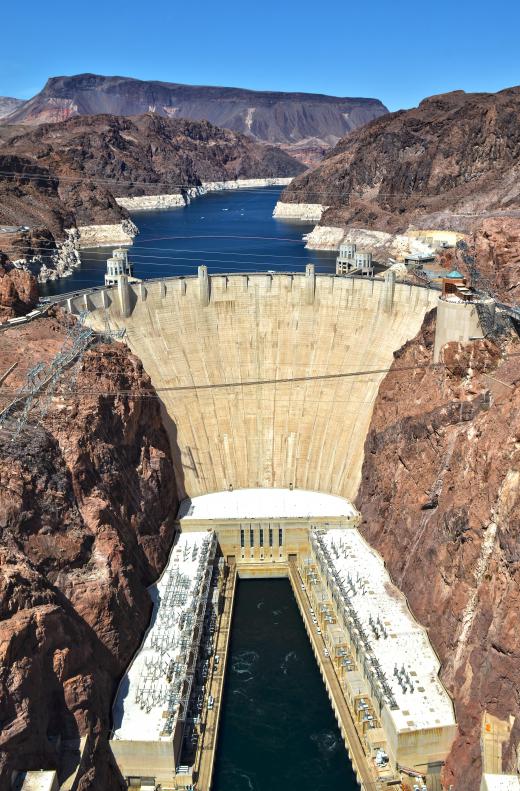How is Electricity Made?
 Nicole Madison
Nicole Madison
There are many different ways to make electricity. Each method involves the use of a turbine to spin and convert kinetic energy into electric energy. Electricity is made when a turbine moves a large magnet around a very large wire. This movement serves to electrify the wire. The energy is then pushed away from the generator through special transformers.
Steam, combustion gases, and water are commonly used to turn turbines for the creation of electricity. Wind may be used as well. When steam is used, fossil fuels, such as oil, gas, or coal, are often burned for the purpose of creating steam from water. The steam is then used to spin the turbine.
Sometimes, nuclear energy is used to create steam to turn turbines. When nuclear power is used, uranium is split apart, creating heat energy. The heat energy is applied to water, creating steam for use in turning a turbine.

Combustion gases may be used to create electricity. In such cases, a gas turbine is employed in burning natural gas or low-sulfur oil. The fuel is mixed with compressed air and burned in combustion chambers. In these chambers, high-pressure combustion gases form and are then applied to the turbine, causing it to turn.
Sometimes water is used in the creation of electricity. In such a case, water is made to fall on the blades of a turbine, turning it. This requires an incredibly large amount of water that is usually obtained from a reservoir or a lake. The body of water must be located higher than the turbine in order to turn its enormous blades.

Once created, electricity travels to a transformer and is changed from low to high-voltage. This is an important step, as it gives electricity the jolt it needs to travel from the power plant to its ending destinations. High-voltage electrical current moves within thick transmission lines.
Traveling current is kept high above the ground by transmission towers, and insulators are employed for the purpose of keeping the energy in the transmission lines. Transmission towers and insulators are vital for ensuring the safe transportation of electricity.
AS FEATURED ON:
AS FEATURED ON:















Discussion Comments
How do you produce nuclear electricity?
@anon76130: The truth is, nobody has yet discovered how to build a perpetual machine, although I have seen a couple that would be arguably perpetual, weather they can produce electricity or only keep themselves going I am unsure. But my point is just because nobody has done it yet does not mean it's not possible.
I need it without burning fossil fuels.
Wow, this is really interesting stuff. I can't wait to study further regarding electricity.
What will happen if we run out of fossil fuels? This is my worst nightmare, I have bad dreams about the world without fossil fuels.
Imagine life without electricity.
Can you create electricity without fossil fuels?
@anon64524: No, water doesn't conduct. It pushes a wheel, generating electricity.
Are there any other ways of making electricity environment-friendly?
So what would happen if we didn't have any kind of electricity?
This does not list all the ways it can be made.
The most common method is the mechanical one via electromagnets turning followed second by solar.
Electricity: can be generated via sound (piezoelectric); can be generated from light (photovoltaic); can be generated from heat (thermionic); can be generated from salt water (voltaic). Plus many more, so why is it so hard to get freely?
Water itself cannot conduct electricity. You may still be electrocuted by standing in the shower and having electric flow through the water. Sounds like a contradiction? Not really.
Pure water is not a conductor, but the things in water could conduct electricity. (metals, etc). BTW, saltwater will conduct electricity. You can do an experiment with placing water into a bowl and using a batter attached to a flashlight and seeing if it will conduct. -source, science class back in the day.
Is there any practical way to produce electricity by friction?
what would happen if you had a ring on and you put your finger in the electricity flow?
i don't get it. should be more easy to use. please because i think it really can help me with my work. thank you very much and i am a student from manchester. thank you for all your help.
To anon36248: Energy In = Energy Out - efficiency
I'm not sure whose law this is, but I remember it from college. As the mechanics have bearings, gears, etc. energy is lost through the efficiency of the mechanics.
To anon36248, no, it is not possible to create a perpetual machine - that is energy is always lost somewhere along the way, through friction, sound, heat, etc.
What are five ways electricity is made?
anon36248, energy is always being lost in some way or another. So not all the input energy gets turned into electricity, it can be lost as heat or in some other form.
so water does conduct electricity?
To anon36248: I am not an expert but i bet this have been thought of before and it didn't work. I believe it is because it cannot generate enough electricity.
Is there a way to create mini lightning and can electricity be made using air or water particles?
no to the first post. law of thermodynamics.
Is it possible to turn the turbines using the electricity prevouisly made and still have enough left to produce more elcetricity therefore creating an infinite supply of electricity?
What will happen if we feed AC to the field of an AC generator instead of DC?
Post your comments